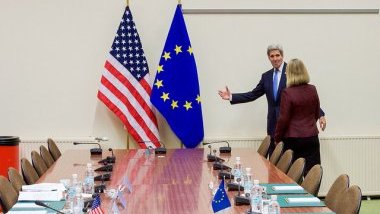“A country without borders is not a country at all”
When US President Donald Trump declared a state of emergency on February 15, 2019, he stated that the construction of a wall on the border between the United States and Mexico was essential in order to put a stop to illegal entries and to establish the national sovereignty, seeing as “without borders there is no state”.
The link between migration and borders is exacerbated to the extent that migrations call into question the inviolability of borders and redefine political identities. This is why both in Europe and in the United States illegal migrations are approached in terms of security matters, choosing a rhetoric related to security: migrations highlight a breach in the capacity of States to control their own territory, which puts their sovereignty in question. Thus, migrations are immediately perceived as a threat to the existence of the nation-state since they can compromise the homogeneity that states seek to create throughout actions which Benedict Anderson describes in his 1983 book Imagined Communities as “mythopoetic”, namely the continual creation of symbols which end up forging a national identity.
However, the construction of this identity is also done by singling out an antagonist who, in this case, is the figure of the migrant in a logic of inclusion and exclusion. This type of language is what Danish researcher Ole Waever describes to be the “grammar of security”, which the American president and Eurosceptics have largely resorted to. However, it should be noted that pro-European like Commission President Jean-Claude Juncker was no stranger to this rhetoric when in September 2018 he declared in his speech on the State of the Union - entitled The Hour of European Sovereignty - that “Europeans rightly expect their Union to keep them safe.”, that “leadership and a spirit of compromise are of course very much needed when it comes to migration”, or that we must”better protect our external borders”.
A difference of nature, and not of degree
This widely diffused practice among American and European politicians fits into the concept of “securitization” (Wæver, 2000), which presents the migrant as a threat and which can serve as a conceptual framework to reflect on the management of migratory flows as a touchstone capable of checking the strength of the political structure of a union of states.
On both sides of the Atlantic Ocean, migration flows have a major impact on policy making, but there is a difference in the nature and not the degree of the consequences of immigration in the United States and Europe.
The United States is a federal government with centralized authority over migration policies, currently governed by the Immigration and Nationality Act, which limits permanent immigrants (legal permanent residents) to 675,000 per year, whilst the Congress and the President determine the number of refugees admitted each year, and the number has been reduced to 30,000 for the fiscal year 2019.
On the other hand, in the EU-28, the crisis is more complex and reveals its lack of political unity, its democratic deficit. The legislative framework currently in force is the Dublin Regulation, adopted in the nineties and today unsuitable for dealing with the dynamics of the migratory phenomenon. However, the inability to reform is indicative of the EU’s difficulty in being a global player in the international arena. Not only are there divergent interests among the Member States, but the populist winds blowing across Europe have contributed to the belief that migratory flows are massive and therefore likely to corrode the national fabric. We may observe how we stand in the presence of a logic of security in its entirety: if migration is considered a threat common to all member states, it is then possible to forge a community of interest and action. Such a strategy had been adopted in the aftermath of the September 11 attacks in the United States with the creation of the Department of Homeland Security dedicated to the preservation of Western civilization in the era of terrorism.
Religion, a facet of multiple implications
A salient difference between Europe and the United States lies in the religion professed by immigrants. The largest group of migrants heading to the United States comes from the “Southern Border”, namely Mexico and Central America. The countries concerned largely share a common faith, Christianity.
On the contrary, a significantly larger cultural and social gap separates the indigenous European population from newcomers from North Africa and sub-Saharan Africa, the Middle East and South-East Asia. In a predominantly Christian Europe, many are Muslim immigrants and their integration into European societies may seem problematic, especially since in some Eastern European countries, the ruling parties proclaim themselves “defenders of Christianity” when facing migration, as is the case for Fidesz in Hungary or for Law and Justice in Poland.
Cultural identity, a national prerogative?
This highlights another constitutive difference between the United States and Europe; whereas the former as a nation are based on common narratives such as “manifest destiny”, “American exceptionalism” or the “American dream”, European identity varies greatly according to the different national contexts and historical experiences.
The historian Ernest Renan believed that memories as well as forgetting matters are “essential factors in the creation of a nation”. Still, when it comes to a union of nations like the EU, the more nations there are in the EU, the family of national memories will be more diverse thus it will be more difficult to build founding myths based on a common past that can serve as a basis also for a common action at the present time. With this in mind, it is understandable that the Eastern European nations which emerged from communism’s grasp and autocracy less than thirty years ago could perceive the European directives on quotas for the distribution of migrants as a violation of their recent sovereignty.
The wall, meant to divide two countries, becomes a divisive factor within the same country
At least since the Treaty of Westphalia, border control is one of the essential prerogatives of any sovereign country and the construction of walls is one of the oldest practices that, from the Great Wall of China to the walls of Vatican, throughout ancient time and continents, continues to be the option chosen in 2019.
But if walls are supposed to divide a country from another country, it can be a much more powerful dividing factor within a single country. Indeed, President Trump’s decision to declare a “national emergency” to build a wall on the border between the United States and Mexico provoked a constitutional clash thus a constitutional crisis about which branch of government (Congress or President) holds the power of the purse thus the expenditure control for the federal budget. With sixteen US states having lodged a legal challenge against the President’s decision, the management of migratory flows thus appears as a testing ground revealing deeper political problems.
On the European side, the wall separating Hungary from Serbia also serves as an external border for the European Union and a common policy on the control of external borders, symbolized by Frontex, remains a battleground for real operational cooperation.
Bilateral agreements, the cure-all?
The construction of walls, however, is only an ex-post response to the problem of illegal migration. Another, potentially more effective, approach is to preemptively tackle the problem by ensuring that people do not even embark on their journey. Both the European Union and the United States have adopted this approach. In 2016 the EU reached an agreement with Turkey to stop the flow of illegal migration from Turkey to Europe, with Turkey agreeing to receive migrants arriving in Greece for a 6 billion euros grant funded by the EU.
This strategy of containment and outsourcing the problem was also adopted in the United States, who concluded the Migrant Protection Protocols with Mexico in January 2019, with the latter agreeing to receive migrants wishing to go to the United States during the immigration proceedings.
However, bilateral agreements cannot be a long-term solution in that they only postpone the problem. Migration management is not a European or American issue. It’s a global challenge and you have to face it as such. Signed in December 2018, the United Nations’ Global Compact for Safe, Orderly and Regular Migration was the first international agreement in the field, but several European countries (including members of the Visegrád Group, Italy and Austria) did not join and the United States did not take part in the negotiations stating that “decisions on border security, on who is legally resident or who may obtain citizenship, are among the most important sovereign decisions that a country can take thus there is no question that they are the subject of negotiations in an international framework”.
Even though after the second world war political scientist Rupert Emerson stated that “the nation and the nation-state are anachronisms in the atomic age”, nowadays we are witnessing the resurgence of nationalist ambitions on both sides of the Atlantic . Will the international order based on multilateralism survive this?





Follow the comments: |
|
